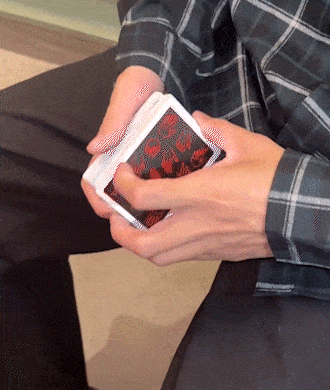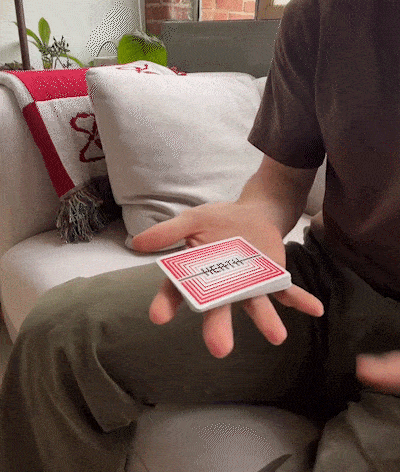What is Cardistry?
A Guest Article by Tom Quan
If you googled that question, you’d probably get some AI-generated slop that says:
“Cardistry is a performance art that uses playing cards to create visual displays, flourishes, and sequences through intricate hand movements.”
If you looked even further, you’d find many descriptions of cardistry from places like blogs, magic forums, Wikipedia, or YouTube. And while each definition says something a little different, every source agrees on one thing: cardistry is an art form.
But what does it mean for cardistry to be considered an art form?After all, do cardists view cardistry the same way they view traditional arts like painting, music, or dance?
A while back, I remember reading a comment from a cardist on Instagram arguing that cardistry shouldn’t be considered an art form. They saw it as nothing more than a skill toy with no room for creativity or expression. From replies, the perspective didn’t seem uncommon, and I think it highlights a tension in how cardistry is perceived. This connection between sheer technical skill and artistic expression is at the core of how we define cardistry.
It’s true that you often see cardistry roped in with other skill toys like kendama, skateboarding, and pen spinning, and in many ways, the culture surrounding cardistry reflects that categorization. Cardistry shares the same emphasis on muscle memory, technical execution, and endless repetition to refine movement. Additionally, it isn’t hard to find a cardist who also practices kendama or pen spinning since the digital subculture of cardistry is nearly identical to those for other skill toys.
But I don’t think it would be quite accurate to say that most skill toys are art forms in the same way we might consider cardistry one. While cardistry thrives in this skill-toy environment, it also breaks out of it. There’s a creative layer to cardistry that isn't always present in other dexterity-based pursuits.
As cliché as it sounds, the possibilities in a deck of cards are limitless, a fact that becomes clear when you look at the variety of styles available—packet cuts, aerials, isolations, interlocks, displays, twirls, and even cardestroy. You aren’t confined to a single, rigid object with an established set of moves; you have the freedom to make something unique and intentional. Even the limitations of a deck are shifted through designs like HOLY from Missing New York. Ultimately, this freedom and ability to create are integral to the definition of cardistry as its own form of expression.
It’s this expressive potential that I believe places cardistry closer to a traditional art form. Cardistry, in a way, pushes the boundary of how ideas are communicated through movement. Just like dance or painting, it's a medium where the performer’s identity, creativity, and intent shine through. The moves that a certain cardist makes, or the way that a certain cardist interprets a move, have a degree of individuality in them that reflects a particular aesthetic, something that can’t be said about most skill-based hobbies. A packet cut can be fast and aggressive, or slow and fluid. The setup for a display can be architectural, intentional, flowy, or somewhere in between. Unlike other skill toys, these details aren’t just technical choices. They’re stylistic choices. After all, it’s pretty easy to distinguish a cut made by Tobias Levin from a cut from someone like Leo Flores since they each have their own unique rhythm, pacing, and flow. This kind of personal imprint elevates cardistry from a collection of tricks into a form of expression.
Beyond the choreography of moves themselves, this individuality extends into how a cardist chooses to present their performances. Cardistry, like all other performance arts, is interdisciplinary in nature, combining elements of videography, music, color, and even fashion. Every detail, from the lighting of a certain shot to the tempo of a soundtrack, has the ability to alter how a move is perceived. The way that shadows interact with a part of a move. The way an outfit matches with the deck. The way a move is framed at certain points. There’s intention behind each frame, each sound, and each aesthetic choice. And in the entire process of creating, filming, and sharing a move, there’s a degree of artistry at each step that I believe deserves more recognition, not just from outside observers, but from cardists themselves.
Because, ultimately, cardistry isn’t just about mastering moves - it’s a visual expression of human creativity. And that makes us artists.
— Tom
Moves of the Month
1. Move by Coninthebox
Making his second appearance in Move of the Month, @coninthebox delivers another eye-catching, thematic flourish — quickly becoming his signature style.
This one stands out for its use of a spread to spin a card not just once, but twice: first on top of the spread, and then again in an Angel position. It’s a seamless, fluid sequence that showcases both creativity and control.
There’s not much more to say — this move speaks for itself. We love seeing creators like Con push the boundaries of what it means to shuffle cards.
2. Diệu Linh by Tủng Dương
Not only does @peter.evangelst use a deck created by Oliver Sogard, but his move feels like a nod to Oliver’s signature style.
That’s not a knock — this flourish still stands firmly on its own. It’s compact, deep in the hands, and full of clever, well-executed multi-packet motions that keep the flow dynamic and engaging. The way packets are combined feels both intentional and satisfying.
It’s a great example of how inspiration can lead to something fresh without losing its own identity.
3. Tiny Tank by Parker Mitchell
Parker has been steadily releasing a solid collection of moves lately — from his Cardistry Con 2024 video to individual flourishes posted on his Instagram, @parkermmmm.
His move stands out thanks to a central packet that glides smoothly around the deck before snapping back into place. It’s a clever blend of flow and flair that adds just the right amount of complexity to elevate an otherwise straightforward structure.
It’s proof that even subtle touches can make a move memorable.
Honorable Mentions
Check out some other high-quality moves released throughout May:
Quick Bites
While AI has proven to be a powerful tool, it still struggles to capture the nuance of complex visual art forms like cardistry. @andrelionel recently ran a test to see how AI interprets cardistry — and the results make one thing clear: for now, the cards are better off in human hands.
Lotus in Hand Singles has reached its grand final, where brothers @the_villain.131 and @santiagoraly come full circle to face off against each other for a massive first-place prize.
Biz wrapped up his 365 Days of Cardistry series — performing a brand-new move every single day for an entire year. An incredible achievement and a true display of dedication.
Sam Pratt taught his classic move Out of Frame on School of Cardistry, with our Revolution T-shirt making a cameo in the tutorial. You can check it out and learn the move here.
@cardistrycore announced the Sybil Contest winner: @radarorleo, who delivered a perfectly clean Sybil with a creative and unexpected twist at the end.





